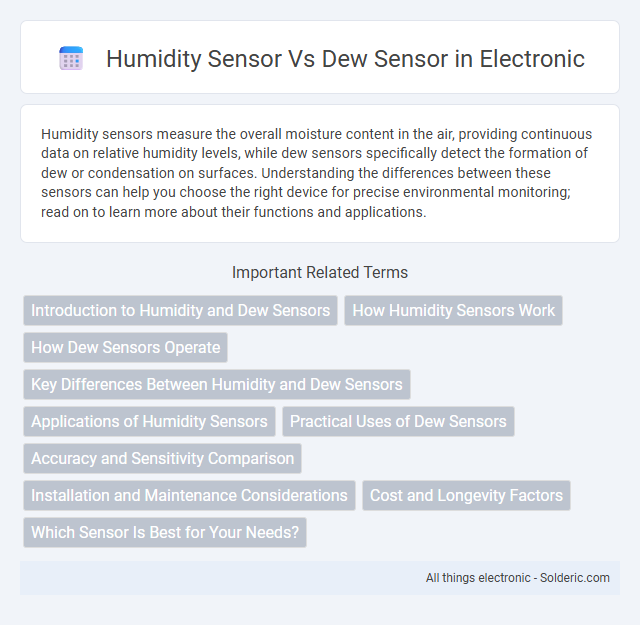Humidity sensors measure the overall moisture content in the air, providing continuous data on relative humidity levels, while dew sensors specifically detect the formation of dew or condensation on surfaces. Understanding the differences between these sensors can help you choose the right device for precise environmental monitoring; read on to learn more about their functions and applications.
Comparison Table
| Feature | Humidity Sensor | Dew Sensor |
|---|---|---|
| Function | Measures relative humidity (%) in the air | Detects presence of dew or moisture on surfaces |
| Measurement Type | Continuous humidity level | Binary detection (dew present/absent) |
| Output | Analog or digital humidity value | Digital signal indicating dew status |
| Typical Use | Weather stations, HVAC, agriculture | Anti-frost systems, outdoor sensors, greenhouse monitoring |
| Sensor Technology | Capacitive, resistive, or thermal humidity sensing | Conductive or optical moisture detection |
| Response Time | Seconds to minutes | Immediate detection on dew formation |
| Accuracy | +-2% to +-5% RH | High sensitivity to moisture presence |
Introduction to Humidity and Dew Sensors
Humidity sensors measure the moisture content in the air, providing accurate data on relative humidity levels essential for climate control and environmental monitoring. Dew sensors specifically detect the formation of dew by sensing surface moisture, which is critical in agricultural and automotive applications to prevent corrosion and optimize irrigation. Your choice between a humidity sensor and a dew sensor depends on whether you need broad atmospheric moisture measurement or precise detection of dew presence on surfaces.
How Humidity Sensors Work
Humidity sensors measure the amount of water vapor in the air by detecting changes in electrical properties such as capacitance or resistance of a hygroscopic material. These sensors output analog or digital signals proportional to relative humidity levels, enabling precise monitoring in climate control, agriculture, and industrial applications. Unlike dew sensors, which specifically detect surface condensation, humidity sensors continuously gauge atmospheric moisture, providing comprehensive environmental data.
How Dew Sensors Operate
Dew sensors operate by detecting the formation of moisture on surfaces through changes in electrical resistance or capacitance caused by water droplets. These sensors typically use a conductive or capacitive sensing element that measures the presence of dew by monitoring surface wetness rather than relative humidity in the air. Unlike general humidity sensors, dew sensors provide direct and precise detection of moisture accumulation critical for applications like weather stations and automatic windshield wipers.
Key Differences Between Humidity and Dew Sensors
Humidity sensors measure the amount of water vapor present in the air, providing real-time relative humidity readings essential for climate control systems, HVAC, and weather monitoring. Dew sensors detect the presence of dew or moisture on surfaces by sensing the formation of liquid water, commonly used in agriculture, automotive, and outdoor equipment to prevent damage or activate protective measures. The key difference lies in humidity sensors quantifying atmospheric moisture content continuously, while dew sensors function as binary indicators detecting the actual deposition of moisture.
Applications of Humidity Sensors
Humidity sensors are widely used in HVAC systems to monitor and control indoor air quality, ensuring comfort and energy efficiency in residential and commercial buildings. They play a crucial role in agriculture by optimizing irrigation and greenhouse conditions to maximize crop yield. Your smart home devices and industrial processes also rely on accurate humidity measurements to prevent equipment damage and maintain product quality.
Practical Uses of Dew Sensors
Dew sensors detect moisture formation on surfaces, making them ideal for agricultural applications where preventing crop damage from dew is crucial. These sensors help optimize irrigation schedules by signaling when dew has evaporated, reducing water waste and protecting plants. Your use of dew sensors can enhance environmental monitoring systems by providing precise data on moisture buildup for improved climate control.
Accuracy and Sensitivity Comparison
Humidity sensors measure the moisture content in the air with moderate accuracy, typically ranging from +-2% to +-5% relative humidity, and respond steadily to gradual environmental changes. Dew sensors are highly sensitive to the onset of surface condensation, detecting the presence of dew with exceptional precision and rapid response times, making them ideal for applications requiring immediate moisture detection. While humidity sensors provide comprehensive air moisture readings, dew sensors excel in pinpointing critical dew formation events with greater sensitivity.
Installation and Maintenance Considerations
Humidity sensors typically require straightforward installation in well-ventilated areas to ensure accurate ambient moisture readings, with minimal maintenance involving periodic calibration to maintain precision. Dew sensors are often installed on surfaces prone to condensation, needing careful placement to detect dew formation accurately, and their maintenance includes regular cleaning to prevent buildup that can affect sensitivity. Understanding your environment's specific needs will help determine the appropriate sensor type and upkeep schedule for optimal performance.
Cost and Longevity Factors
Humidity sensors generally cost less than dew sensors due to simpler technology and widespread availability. Dew sensors often have a longer lifespan when used in outdoor environments because they are designed to directly detect moisture presence, reducing false readings and wear. Your choice should balance initial expense against durability needs, especially for long-term outdoor applications.
Which Sensor Is Best for Your Needs?
Humidity sensors measure the moisture content in the air, providing continuous, quantitative data ideal for HVAC systems and environmental monitoring. Dew sensors detect the presence of condensation on surfaces, making them perfect for applications like automotive windshield control or agricultural frost prevention. Choosing the best sensor depends on whether you need precise humidity levels for air quality management or rapid detection of surface moisture to prevent damage.
humidity sensor vs dew sensor Infographic

 solderic.com
solderic.com